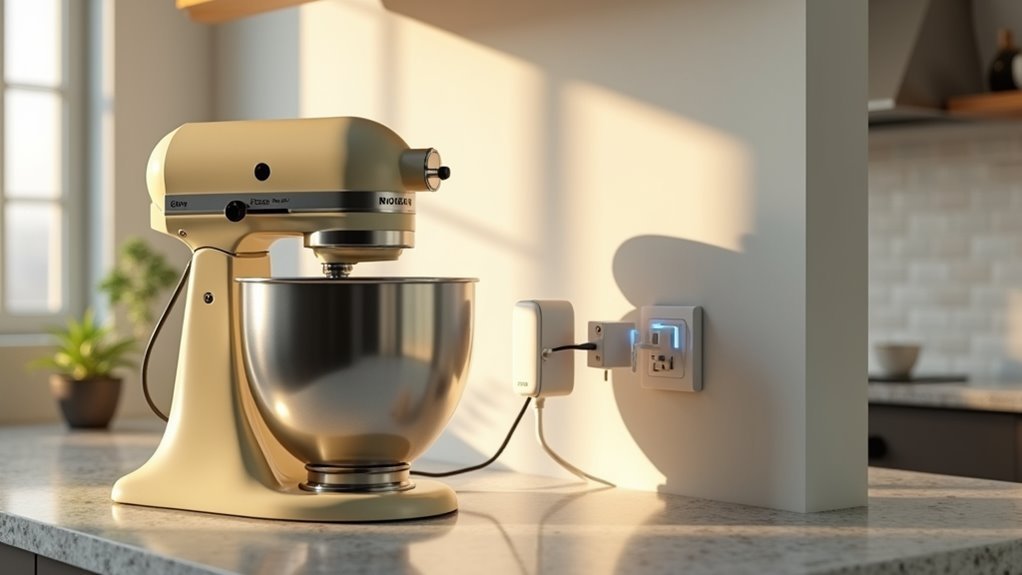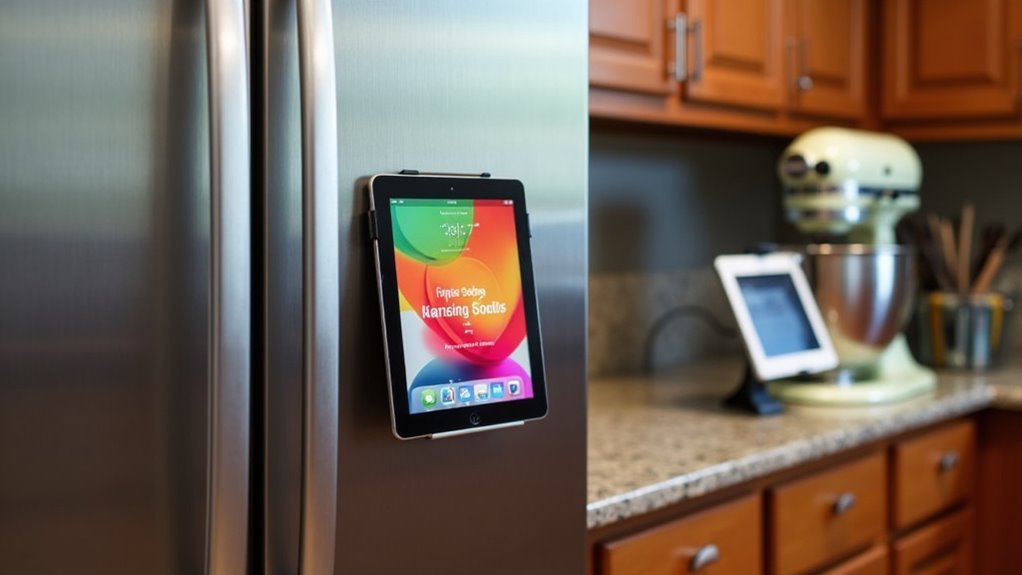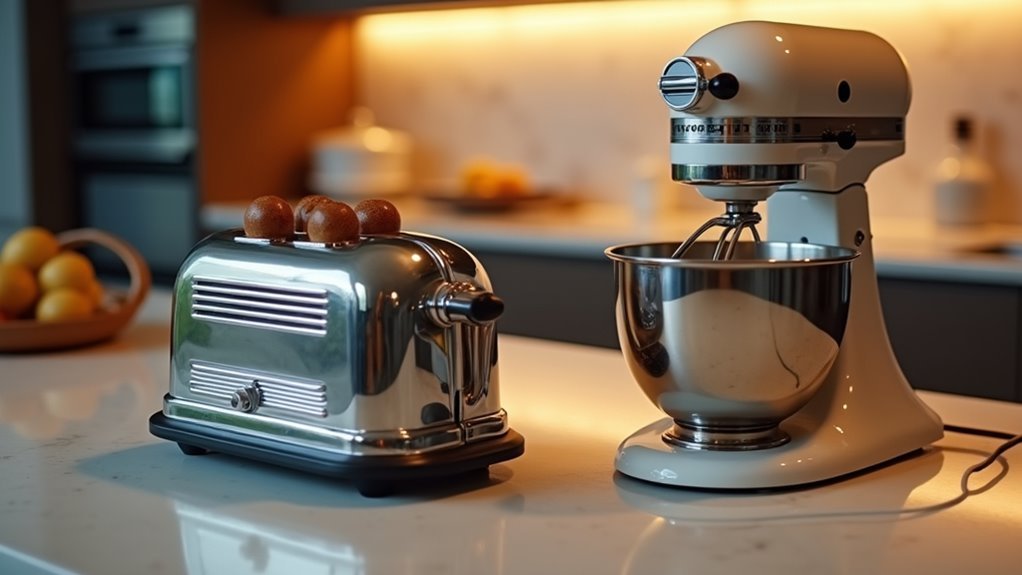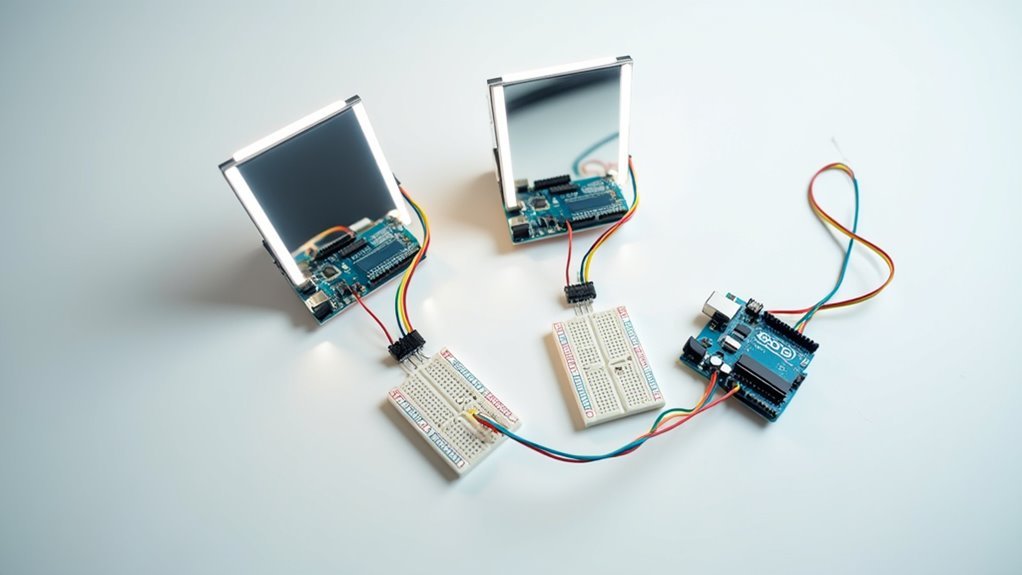You don’t need to spend thousands on brand-new smart appliances when your existing kitchen equipment can be transformed with simple, affordable upgrades. Whether it’s your decade-old coffee maker or that reliable toaster oven, strategic additions like smart plugs, sensors, and voice adapters can breathe new life into these workhorses. The best part? Most transformations cost under $50 and require zero technical expertise, but the results will completely change how you interact with your kitchen.
Smart Plugs: The Simplest Way to Add Intelligence to Any Appliance

While upgrading your entire kitchen with smart appliances can cost thousands of dollars, smart plugs offer a simple $15-50 solution that transforms any standard device into a connected one.
You’ll instantly gain remote control over coffee makers, blenders, and other appliances through smartphone apps or voice commands via Amazon Alexa and Google Assistant.
These devices excel at home automation by enabling scheduling and routines. You can program your coffee maker to start brewing before you wake up or create scenes that coordinate multiple appliances simultaneously.
Smart plugs transform ordinary appliances into automated assistants that work on your schedule, not the other way around.
Many smart plugs include energy monitoring features, letting you track electricity consumption and identify cost-saving opportunities.
Smart kitchen appliances become accessible to everyone through this affordable upgrade path, eliminating the need for expensive replacements while delivering modern convenience and efficiency.
Installing Smart Sensors for Temperature and Usage Monitoring
Smart sensors take your kitchen monitoring capabilities beyond basic appliance control by tracking critical environmental factors like temperature and humidity. You’ll want to install these devices in refrigerators and freezers to guarantee ideal food preservation conditions. Systems like YoLink, which includes two sensors and a hub for around $60, provide real-time temperature monitoring and alert you when doors are left open.
| Feature | Benefit | Cost Range |
|---|---|---|
| Temperature Alerts | Prevents food spoilage | $30-80 |
| Door Monitoring | Energy savings | Included |
| Remote Notifications | Instant awareness | App-based |
| Humidity Tracking | Extended freshness | Standard |
| Usage Analytics | Reduced food waste | Data-driven |
You can even monitor cold brew coffee steeping or track when items approach spoilage, greatly reducing food waste through smartphone app integration.
Adding Tablet Mounts for Recipe Access and Control Interfaces

You’ll want to position your tablet mount at eye level near your primary prep area, typically on the refrigerator or a cabinet door that’s easily visible while cooking.
Consider locations that keep the device away from steam and splashes while maintaining quick access to recipe instructions and smart home controls.
Voice control integration becomes essential when your hands are messy, so you’ll need compatible voice assistants that can navigate recipes, set timers, and adjust connected appliances without touching the screen.
Optimal Tablet Mounting Locations
Where should you mount your tablet to maximize both functionality and convenience in your smart kitchen? Strategic placement transforms your tablet into one of the most valuable kitchen gadgets for controlling smart appliances and accessing digital recipes.
| Location | Benefits | Considerations |
|---|---|---|
| Fridge side | Counter space preservation | Eye-level positioning |
| Cabinet door | Hidden storage option | Power outlet proximity |
| Wall mount | Ideal viewing angle | Wi-Fi signal strength |
Mount your tablet at eye level for comfortable recipe reading and timer monitoring. Use magnetic mounts for secure attachment while allowing easy removal when needed. Position near power outlets to maintain charging capabilities during extended cooking sessions. Guarantee strong Wi-Fi connectivity for uninterrupted access to online recipes and smart appliance controls.
Voice Control Integration Options
While mounting your tablet creates an excellent visual interface, integrating voice control transforms your kitchen into a hands-free culinary command center.
You’ll want to pair your tablet with devices like the Amazon Echo Dot to enable seamless voice commands while cooking. This combination turns your setup into an all-encompassing smart hub that responds instantly to your needs.
Voice control integration offers several practical advantages:
- Hands-free recipe navigation when your hands are messy or occupied
- Timer management through simple voice commands during multi-step cooking
- Smart plugs activation to remotely control coffee makers and slow cookers
- Grocery list updates without interrupting your cooking workflow
This voice-enabled system lets you control connected appliances, access cooking guidance, and manage kitchen tasks without touching screens or buttons.
Retrofitting Voice Control With Smart Speakers and Adapters
You can transform your existing kitchen appliances into voice-controlled devices by strategically placing smart speakers and using compatible adapters.
The setup process involves connecting your appliances through smart plugs, IR adapters, or specialized controllers that bridge the gap between older technology and modern voice assistants.
With the right combination of Amazon Echo, Google Nest, or similar devices paired with solutions like BroadLink adapters, you’ll gain hands-free control over everything from your coffee maker to your oven.
Smart Speaker Integration Methods
How can you transform your traditional kitchen appliances into voice-controlled smart devices without replacing everything? The answer lies in strategic integration using smart speakers and compatible adapters.
You’ll discover that smart plugs offer the simplest entry point, allowing you to control any appliance remotely through voice commands via Amazon Alexa or Google Assistant.
Smart adapters provide another effective solution by connecting directly to existing devices, enabling hands-free operation without permanent modifications.
Here are four key integration methods:
- Smart plugs – Control power to any appliance with voice commands
- Smart adapters – Add connectivity to specific device types
- Routine automation – Synchronize multiple appliances with single commands
- Hub centralization – Manage all retrofitted devices from one platform
These methods transform your kitchen into a cohesive smart ecosystem.
Voice Command Setup Process
Where should you begin when setting up voice commands for your retrofitted kitchen appliances? Start by downloading the app for your chosen smart plugs or adapters.
Connect these devices to your home Wi-Fi network through the app’s setup wizard. Next, link your smart plugs to your smart speaker by enabling the corresponding skill or service in your voice assistant’s app.
You’ll need to discover devices so your smart speaker recognizes your newly connected appliances.
Test the voice control functionality by giving simple commands like “turn on coffee maker” or “start blender.” Create custom names for your appliances that are easy to remember and pronounce.
Finally, explore advanced features like scheduling and grouping multiple devices for streamlined kitchen management through voice commands.
Compatible Adapter Solutions
Several adapter solutions can transform your existing kitchen appliances into voice-controlled smart devices without requiring costly replacements.
Smart plugs serve as the foundation for this transformation, allowing you to control any plugged-in appliance through smartphone apps or voice commands via Amazon Echo or Google Home speakers.
Compatible adapter solutions extend beyond basic plugs to include specialized devices that enhance specific appliances:
- Smart meat thermometers like Chef IQ provide real-time cooking updates and alerts
- Temperature and humidity sensors retrofit refrigerators and freezers with monitoring capabilities
- Tablet mounts transform regular fridges into smart information hubs
- Voice-enabled switches replace standard wall switches for built-in appliances
These smart technology additions create seamless integration between your existing kitchen equipment and modern home automation systems.
Converting Standard Ovens With Smart Temperature Probes
While you don’t need to replace your entire oven to enjoy smart cooking benefits, converting your standard oven with smart temperature probes offers an affordable path to precision cooking. These devices, like the Chef IQ smart meat thermometer, connect via Bluetooth or Wi-Fi to deliver real-time cooking data straight to your smartphone.
You’ll gain cooking accuracy that rivals expensive smart oven models without the hefty price tag. The probes monitor internal food temperatures continuously, eliminating guesswork and preventing overcooking.
| Traditional Cooking | Smart Temperature Probes |
|---|---|
| Constant oven opening | Monitor without interruption |
| Temperature guesswork | Precise internal readings |
| Overcooking anxiety | Confident, perfect results |
| Recipe uncertainty | Guided cooking assistance |
These smart temperature probes transform your standard oven into a precision cooking machine.
Upgrading Refrigerators With Smart Cameras and Inventory Trackers
You can transform your existing refrigerator into a smart appliance by installing camera systems that let you view contents remotely through your smartphone.
These upgrades help you track what’s inside without opening the door, reducing energy waste and preventing forgotten items from spoiling.
Adding inventory management features takes this further by sending expiration alerts and automatically generating shopping lists based on your current stock.
Installing Smart Camera Systems
How often have you opened your refrigerator only to discover expired food hiding in the back corners?
Installing smart cameras transforms your old refrigerator into an intelligent food management system. These cameras work with inventory tracking technology to monitor your food in real-time, automatically recognizing items and updating your grocery lists.
The installation process enables several key benefits:
- Real-time food monitoring prevents waste by identifying expiration dates
- Automatic inventory updates streamline meal planning and grocery shopping
- Remote control access lets you check fridge contents via smartphone apps
- Door-open alerts help conserve energy and maintain food freshness
Once installed, you’ll access your fridge contents from anywhere through cloud storage, making grocery shopping more informed and efficient.
Adding Inventory Management Features
Smart cameras provide the foundation, but adding dedicated inventory management features maximizes your refrigerator’s potential.
Install smart inventory trackers that automatically monitor your groceries and send expiration date alerts to your smartphone. This prevents food waste and helps you plan meals based on available ingredients.
Consider DIY solutions like YoLink kits, which include sensors for monitoring temperature and humidity levels to preserve perishables longer.
Your smart fridge becomes even more efficient when you integrate apps that create grocery lists directly from tracked contents, streamlining your shopping trips.
Keep your inventory management system updated with regular software updates to reveal new features and improve functionality over time.
This thorough approach transforms basic refrigerator monitoring into sophisticated household management.
Transforming Coffee Makers With Timer Modules and App Control
While expensive smart coffee makers dominate the market, you can transform your existing machine into a connected appliance with simple timer modules and app-controlled smart plugs.
These affordable upgrades let you schedule brewing times for fresh coffee at your wake-up hour. App-controlled smart plugs enable remote activation through your smartphone, while timer modules provide automated scheduling.
You’ll gain additional benefits like energy monitoring to track your coffee maker’s power consumption.
Key transformation options include:
- Installing timer modules for scheduled brewing without smartphone dependency
- Using smart plugs for remote smartphone control and energy tracking
- Integrating smart hubs to create automated morning routines
- Combining both solutions for customized brewing schedules and full automation
DIY enthusiasts successfully merge these technologies with existing coffee makers, creating personalized automation without replacing entire appliances.
Adding Smart Switches for Remote Appliance Management
Smart switches offer you the most straightforward path to transform your existing kitchen appliances into remotely controlled devices without replacing them entirely.
You can install these switches between your appliances and power outlets, instantly enabling smartphone and voice control for everything from coffee makers to slow cookers.
This upgrade delivers immediate benefits like scheduling your morning brew, monitoring energy usage, and operating appliances hands-free while you’re cooking.
Smart Switch Installation Process
Before you begin upgrading your home’s electrical system, you’ll need to turn off the power at the circuit breaker to verify your safety during installation.
Installing smart switches transforms your kitchen appliances into controllable devices within your smart home ecosystem.
Here’s the essential installation process:
- Remove your existing switch and disconnect the wires
- Connect the smart switch following manufacturer’s wiring instructions
- Confirm your home has neutral wire compatibility for proper operation
- Secure the switch in place and restore power for testing
Once installed, download the manufacturer’s app to configure your control and automation settings.
You’ll be able to schedule appliances, create automated routines, and integrate with voice assistants.
Regular firmware updates will enhance functionality and security over time.
Compatible Appliance Types
Retrofitting transforms your existing kitchen appliances into smart, controllable devices without requiring expensive replacements.
Smart plugs work seamlessly with most standard appliances that operate on 120V outlets, making them universally compatible with your current kitchen setup.
You can upgrade slow cookers, coffee pots, and electric kettles by simply plugging them into smart plugs. These devices instantly gain scheduling capabilities, allowing you to brew morning coffee or warm meals at predetermined times.
Voice control through Amazon Alexa or Google Assistant adds hands-free convenience to any compatible appliance.
Smart kitchen technology extends beyond cooking devices to include lighting fixtures and small countertop appliances.
Energy monitoring features help you track electricity usage across all connected devices, creating an efficient, interconnected kitchen ecosystem without costly appliance replacements.
Remote Control Benefits
When you install smart switches in your kitchen, you’ll gain complete control over your appliances from anywhere in your home or even while you’re away.
Remote control functionality transforms how you interact with everyday devices, letting you manage everything through your smartphone app.
You’ll receive real-time notifications about appliance status, knowing exactly when your coffee’s ready or your slow cooker’s finished.
Smart switches also enhance safety by enabling you to turn off forgotten appliances remotely, preventing potential hazards.
Key remote control benefits include:
- Schedule appliances to run during off-peak energy hours
- Monitor device operation status in real-time
- Turn off forgotten appliances for enhanced safety
- Control multiple kitchen devices from a single app interface
Voice integration with Alexa or Google Assistant adds hands-free convenience to your smart kitchen setup.
Installing Motion Sensors for Hands-Free Operation
As you prepare meals with messy hands or carry multiple ingredients, motion sensors transform your kitchen into a touchless workspace where simple gestures control appliances and lighting.
These infrared-based devices detect your body heat and movement, responding accurately when you’re near appliances needing activation.
Installing motion sensors for hands-free operation requires connecting them to your smart home hub through simple wiring or adhesive mounts.
You’ll appreciate the customizable settings that let you adjust sensitivity and response time based on your kitchen’s layout and cooking habits.
The convenience factor becomes immediately apparent when you’re handling raw ingredients or juggling multiple tasks.
Motion sensors eliminate the frustration of constantly washing hands or struggling with sticky fingers while managing multiple cooking tasks simultaneously.
You won’t need to touch surfaces, maintaining better hygiene while streamlining your cooking process through intuitive gesture controls.
Creating Custom Automation With Smart Relays and Timers
Smart relays and timers activate the potential of your existing appliances, transforming ordinary kitchen equipment into intelligent, automated systems.
You’ll turn any standard device into a smart appliance by installing these affordable components, enabling remote control through smartphone apps or voice commands.
These versatile tools integrate seamlessly with your existing smart home hub, creating cohesive automation scenarios.
You can schedule your coffee maker to brew at precisely 6 AM or monitor energy consumption to reduce utility costs.
Consider these practical automation possibilities:
- Schedule slow cookers to start cooking while you’re at work
- Automatically turn on lights when your coffee maker begins brewing
- Set toasters to preheat at specific breakfast times
- Create energy-saving schedules for multiple appliances simultaneously
Smart relays make custom automation accessible and affordable for any kitchen.
Adding Wi-Fi Connectivity to Non-Connected Appliances
While replacing every kitchen appliance isn’t practical or budget-friendly, you can transform your existing devices into Wi-Fi-enabled smart appliances with simple, cost-effective upgrades.
Smart plugs offer the easiest solution for adding Wi-Fi connectivity to traditional appliances. You’ll control slow cookers, coffee makers, and blenders remotely through smartphone apps or voice commands. These devices work by plugging into standard outlets and connecting your appliances to your home network.
| Appliance Type | Smart Upgrade | Control Method |
|---|---|---|
| Coffee Maker | Smart Plug | App/Voice |
| Slow Cooker | Smart Plug | Remote Timer |
| Blender | Smart Plug | Scheduled Use |
| Toaster | Smart Plug | Voice Commands |
| Rice Cooker | Smart Plug | Mobile App |
A smart home hub integrates these upgrades, allowing seamless control alongside modern smart gadgets for enhanced kitchen efficiency.
Using Smart Power Strips for Multiple Appliance Control
Beyond upgrading individual appliances, you’ll find smart power strips provide centralized control over multiple kitchen devices from a single hub.
These innovative strips let you manage multiple appliances simultaneously through one app or voice command, streamlining your cooking workflow.
Smart power strips offer several advantages for kitchen automation:
- Energy monitoring – Track real-time consumption data to reduce electricity costs
- Individual outlet control – Schedule specific devices like coffee makers or slow cookers
- Surge protection – Safeguard connected appliances from power damage
- Smart home integration – Connect seamlessly with existing automation systems
You can remotely activate devices, automate daily routines, and monitor energy usage patterns.
This centralized approach transforms your kitchen into an efficient, connected workspace without replacing every appliance individually.
Integrating Existing Appliances With Home Assistant Platforms
Even if your current appliances lack built-in smart features, you can transform them into connected devices using home assistant platforms like Google Home, Amazon Alexa, or Apple HomeKit.
Smart plugs are your gateway to control devices like slow cookers and coffee pots remotely through smartphone apps or voice commands. You’ll gain instant control over appliances that previously required manual operation.
A smart home hub centralizes management of your integrated devices, enabling automated routines and synchronized operations for seamless kitchen experiences.
You can upgrade traditional ovens with smart meat thermometers for live cooking updates sent to your smartphone. Smart sensors added to refrigerators provide real-time temperature monitoring, while smart bulbs offer customizable lighting through voice control, creating an efficiently connected kitchen ecosystem.
Budget-Friendly Smart Kitchen Upgrades Under $50
Transforming your kitchen into a smart culinary space doesn’t require a massive investment or complete appliance replacement. You can achieve significant upgrades for under $50 that’ll revolutionize your cooking experience.
Smart plugs under $50 let you control existing appliances like slow cookers and coffee pots remotely, enabling scheduled operation and smart home integration.
Voice-controlled devices ranging from $25 to $50 provide hands-free kitchen gadget operation and recipe guidance during meal prep.
Smart bulbs costing $15 to $30 offer customizable brightness and color temperature control through apps or voice commands.
Budget-friendly options include:
- Smart temperature sensors ($60 for thorough monitoring)
- Remote-controlled smart plugs for appliance automation
- Voice assistants for hands-free cooking assistance
- App-controlled lighting for ideal cooking ambiance
These affordable upgrades transform ordinary kitchens into efficient, connected spaces.
Frequently Asked Questions
How to Make Your Appliances Smart?
You can upgrade existing appliances using smart plugs for remote control, adding tablets with magnetic mounts, installing temperature sensors, incorporating smart thermometers for ovens, and replacing regular bulbs with smart lighting options.
What Are the Disadvantages of Smart Kitchen?
You’ll face high upfront costs, internet dependency issues, security vulnerabilities from hacking, compatibility problems between devices, and complex maintenance requirements that often need specialized knowledge or professional support.
What Color Appliances Never Go Out of Style?
You can’t go wrong with classic white, black, or stainless steel appliances. They’re timeless choices that’ll stay stylish through changing trends and appeal to future buyers if you decide to sell.
How to Design a Smart Kitchen?
You’ll want to prioritize workflow efficiency by creating a kitchen triangle between smart appliances. Install a central hub for seamless control, position devices strategically to minimize movement, and choose aesthetically pleasing smart gadgets that enhance functionality.





Leave a Reply